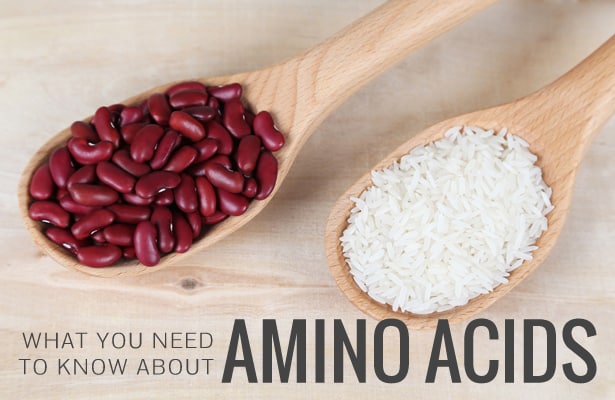
As vegetarians, we hear a lot of talk about protein. How do we get enough, is it of high enough quality, and is it complete or incomplete. But what does all of this mean? It all starts with amino acids.
Amino acids are the building blocks of life. In science talk, they’re an organic compound containing both a carboxyl (-COOH) and an amino group (-NH2). Amino acids bond together to form long chains, otherwise known as proteins.
In total, there are 20 amino acids. Nine of these are essential:
- Histidine
- Isoleucine
- Leucine
- Lysine
- Methionine
- Phenylalanine
- Threonine
- Tryptophan
- Valine
And the rest are non-essential:
- Alanine
- Arginine*
- Asparagine
- Aspartic acid
- Cysteine*
- Glutamic acid
- Glutamine*
- Glycine
- Pyrrolysine*
- Proline*
- Selenocysteine*
- Serine*
- Tyrosine*
Some of the non-essential amino acids, however, are considered conditionally essential (indicated with *) because they are essential only in certain cases. Many of the conditionally essential amino acids are essential in children, but not adults.
The difference between essential and non-essential amino acids is that our (adult) bodies have the capacity to synthesize the non-essential ones. The other nine, we’re not able to make ourselves, so it is essential that we get these in our diets. Get it?
A protein that contains all nine essential amino acids is referred to as a complete protein, or sometimes as a high quality protein. If a protein is missing one or more essential amino acid, it’s referred to as an incomplete or low quality protein.
What’s important for us veggies to know is that most (but not all) plant-based proteins are incomplete. In order to form a complete protein, it’s necessary to combine foods that can make up the missing essential amino acids. These are called complementary proteins.
For example, most beans are low in methionine and high in lysine. Rice is low in lysine and high in methionine. But a big ol’ plate of rice ‘n’ beans? Pow! Now we’ve got a complete protein.
The old theory was that vegetarians needed to eat these complementary proteins at the same meal in order to get all the amino acids we needed. But, we now know that our bodies are smarter than that.
When we consume protein, it gets broken down into individual amino acids in the gastro-intestinal tract and stored in an amino acid ‘pool’. Amino acids are later taken from the pool and put back together as new proteins. The entire amino acid pool gets exchanged three to four times per day. As long as there’s a constant supply of amino acids entering the pool (some from the diet, some from protein biosynthesis), we’re in business. So we don’t need every essential amino acid in every bite of food we eat, just a sufficient amount of each every day.
Most plant-based diets contain such a wide variety of amino acids that vegans are more or less guaranteed to get all of their amino acids with very little effort. Also, there are plant-based proteins that do contain all nine essential amino acids, including:
- Quinoa
- Buckwheat
- Chia
- Hemp
- Soy
And there are many other delicious ways to combine for complementary proteins, most often by combining a legume (beans, lentils, peanuts) with a grain (rice, wheat, corn) such as:
- Hummus and pita
- Peanut butter on toast
- Tortilla chips and bean dip
- Chickpea wrap
So the bottom line is, although many vegetarian foods are incomplete proteins on their own, as long as we’re eating a varied diet, getting those essential amino acids shouldn’t be a problem. Let’s celebrate with some rice ‘n’ beans!
Rice and beans photo via Shutterstock.


Millie | Add A Little says
What a wonderful list - so easy to understand and follow!
Katie Trant says
Glad you found it helpful, Millie!
Katie says
I'm still new to the vegetarian lifestyle (just under 2 months!) so this was really helpful to read! It makes more sense now xD
Katie Trant says
That's great, Katie! It can seem a bit overwhelming at first, but it's really not so complicated to get complete proteins in your life.
Emily says
Great post! Thanks for explaining things so clearly!
Katie Trant says
You're welcome! Glad you liked it!
Marco Van Basten says
This was very helpful, thank you.